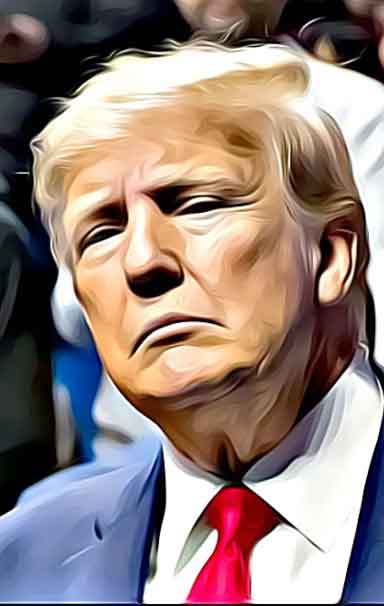
"The wall is going to cost $10 billion. It's so easy. . . . They say you'll never be able to build a wall. Well, it's 2,000 miles but we really need 1,000 miles. The Great Wall of China, built 2,000 years ago, is 13,000 miles, folks. . . . They didn't have cranes. They didn't have excavation equipment. The wall is 13,000 miles long. We need 1,000 miles and we have all of the materials."
— Donald Trump, news conference at Mar-a-Lago, March 1, 2016
"Two thousand years ago, China built the Great Wall of China. This is a serious wall. And they didn't have Caterpillar tractors. . . . But they didn't have the equipment. And they built a wall. Think of this: 13,000 miles long, and this is a serious wall, okay? This wall is wide."
— Trump, campaign event at Liberty University, Jan. 18, 2016
![]()
As we all know by now, Trump wants to build a wall along the U.S.-Mexico border. China did it, after all, and Trump's wall will only be a fraction of what the Chinese built, he frequently explains. And the Chinese didn't even have the building materials we do now!
We get why it's easy to hearken the world heritage site whose name contains two of Trump's favorite words ("great," "wall"), as it may seem like an iconic physical barrier erected to protect a country's borders. But this is a moot comparison, as history buffs know.
Trump keeps making the comparison anyway, and he has done so since early on his campaign, joking that he would name the wall the "Great Wall of Trump." And he insists on a questionable estimate for the cost of his wall, which we have debunked. Let's look at the facts.
![]()
Unlike what its name implies, the Great Wall of China is actually a non-contiguous series of walls, trenches, natural barriers and fortresses built in different locations along the border between northern China and southern Mongolia.
It took a long time to build - over dynasties. The earliest construction of fortifications dates to the Warring States period from the 7th through the 4th century Before the Common Era, and the Qin Dynasty of 3rd century Before the Common Era to protect against foreign invaders. The fortifications and castles were used to control commerce or prevent rebellions under Mongolian control of China.
The majority of what we consider now as the Great Wall was built over some two centuries from 1368-1644 during the Ming Dynasty, after Beijing was made the new capital of China.
The Ming Dynasty wall measures at 5,499 miles - of which 3,889 miles (70 percent) were actual wall. The figure that Trump uses (13,000 miles) is the updated calculation of the entire wall system combined, including watchtowers, trenches and natural defensive barriers like rivers and hills.
Ming rulers invested in its construction to prevent future attacks from Mongols from the north and to deny a trade relationship with barbaric nomads attacking Chinese farmers for grain and other products.
"They are better understood as capital rather than national defenses. Vast amounts of money were spent and they had some effect. But late in the [Ming] dynasty, a genius of a minister decided to permit markets to serve the nomads - and defense expenses collapsed," said Arthur Waldron, University of Pennsylvania historian in Chinese studies and author of "The Great Wall of China: From History to Myth."
Plus, it wasn't an effective security barrier. As our colleague Ishaan Tharoor wrote: "The Great Wall of China, for all its majesty, was very porous. While a towering monument to Chinese civilization, it was hardly impregnable. The Mongols, Manchus and others all breached this great defense and went on to establish their dominion behind its ramparts. Perhaps that's the best way for Trump to understand the Great Wall's significance - not as a security barrier, but as a work of political propaganda."
Trump says the Chinese were able to build the wall even without imported equipment, like Caterpillar tractors. Sure. The Chinese didn't have tractors, but they did use forced labor of peasants, criminals and soldiers.
Labor conditions were so appalling that some 400,000 people are estimated to have died building the wall. The longest human construction project in history was also called the "longest cemetery on Earth" when it was being built.
In Chinese poetry and through most of Chinese history, the wall was a negative symbol of oppression, cruelty and death, Waldron said - the wall as a symbol of strength and resourcefulness is a part of the myth and misconception of its true history.
Trump says he would only need to build 1,000 miles of new walls along the U.S.-Mexico border because there are "natural barriers."
Border security experts say he is most likely is referring to the deserts along the border, where many migrants have died.
Trump continues to assert that the wall would cost $10 billion, without providing any serious discussion of the costs. But that's simply not credible.
For major government projects, $10 billion is not a huge sum. The cost of 1,000 miles of fences - not even a concrete wall - is at least $3 billion. That's not even including the upkeep and maintenance. The Corps of Engineers estimated that the 25-year life cycle cost of the fence would range from $16.4 million to $70 million per mile; the total cost of the fencing so far has been $7 billion, according to the Congressional Research Service.
A concrete wall would cost much more than that. We updated calculations done by a structural engineer in an article in The National Memo and found raw materials alone would cost $2 billion. A retired estimator and economist for one of the nation's largest construction firms worked through some of the math and said a wall of this type would cost at least $25 billion. That's not even counting the video system to keep watch on the border.
The border is much harder today to cross than in the past, experts said, thanks to a mix of the proliferation of fencing and walls, increased Border Patrol presence, aerial surveillance and ground sensors. New walls alone wouldn't help increase security, as a physical barrier is just one portion of border security.
Increased enforcement efforts along the border may explain about 35 to 40 percent of the decline in illegal immigration flow, said Edward Alden, trade policy expert at the Council on Foreign Relations. Trump's wall is "a rhetorical talking point and a half-thought-out idea that sounds good to people who don't understand what they're talking about," Alden said.
The focus on building a wall overlooks many of the other reasons that have led to the number of unauthorized migrants in the country, experts say. Walls are not impregnable - as shown in the example of the Great Wall of China - and simply putting more of it up doesn't help. "You're dealing with symptoms. You've really got to look at the deeper issue of immigrant labor that our economy uses," said Nestor Rodriguez, University of Texas at Austin professor and immigration researcher.
![]()
Unless Trump is running to be the emperor of the United States and plans to build a series of fortresses, walls and trenches that will be added on to for dynasties to come beyond a Trump Dynasty, he should really drop this nonsense assertion. It is an apples-to-oranges comparison that shows the Republican front-runner's lack of understanding of the history behind the Great Wall of China, which was built over many millennia to meet a variety of commerce and defensive needs of certain dynasties. And as a security measure, it was not an effective barrier.
Moreover, Trump continues to assert a questionable estimate for his wall that is much lower than experts have calculated. As we've said before, we welcome a serious discussion of costs and benefits of building a wall along the U.S.-Mexico border, rather than wild rhetoric. Neither his comparison to China nor the wall estimate is rooted in any factual basis.
Comment by clicking here.
An award-winning journalism career spanning nearly three decades, Glenn Kessler has covered foreign policy, economic policy, the White House, Congress, politics, airline safety and Wall Street. He was The Washington Post's chief State Department reporter for nine years, traveling around the world with three different Secretaries of State. Before that, he covered tax and budget policy for The Washington Post and also served as the newspaper's national business editor. Kessler has long specialized in digging beyond the conventional wisdom, such as when he earned a "laurel" from the Columbia Journalism Review



 Contact The Editor
Contact The Editor
 Articles By This Author
Articles By This Author